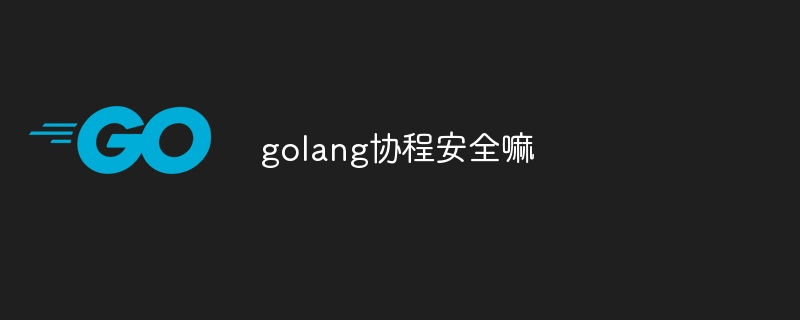
Golang coroutine security can be ensured through the features provided by the language itself, such as memory models, mutex locks, read-write locks, and atomic operations. When writing Golang programs, you also need to Follow some best practices, such as avoiding shared state and global variables, using locks correctly, etc., to ensure the safety of coroutines.

The operating environment of this article: Windows 10 system, Go1.20.4 version, Dell G3 computer.
Golang coroutine security is a very important topic. In this 1500-word answer, I will explain in detail the characteristics of Golang coroutine and how to ensure the security of the coroutine.
First, let us understand the basic concepts of Golang coroutines. Golang is a concurrent programming language that implements concurrency through lightweight goroutines. A coroutine is a lightweight thread that is scheduled by the Go runtime. It can run on one or more threads and can be dynamically created and destroyed. The cost of creating and destroying coroutines is very low, so a large number of coroutines can be created to handle concurrent tasks without causing too much system overhead.
Communication between coroutines is implemented through channels. A channel is a first-in, first-out data structure that can pass data between coroutines. Coroutines can interact with other coroutines by sending data to channels, and can also obtain data sent by other coroutines by receiving data from channels. Through the synchronization feature of the channel, synchronization and mutual exclusion between coroutines can be achieved.
In Golang, the security of coroutines is guaranteed by some features provided by the language itself. First of all, Golang's memory model ensures the consistency of memory access between multiple coroutines. The memory model in Golang is based on the sequential consistency model, which means that for a coroutine, all memory operations it sees are executed in the order in the program. This avoids data race problems caused by out-of-order execution of memory accesses.
Secondly, Golang provides synchronization primitives such as mutex (mutex) and read-write lock (rwmutex) to protect access to shared resources. Coroutines can ensure mutually exclusive access to shared resources by using mutex locks, that is, only one coroutine can access the resource at the same time. Read-write locks can more flexibly control access to shared resources, allowing multiple coroutines to read shared resources at the same time, but only allow one coroutine to perform write operations. By using these synchronization primitives, data competition problems caused by multiple coroutines accessing shared resources at the same time can be effectively avoided.
In addition, Golang also provides atomic operations (atomic) to ensure atomic operations on shared resources. An atomic operation is an indivisible operation that is either performed completely or not performed at all. Golang's atomic operations can ensure that read and write operations on shared resources are atomic, that is, they will not be interrupted by other coroutines. By using atomic operations, you can avoid data race problems caused by multiple coroutines reading and writing shared resources at the same time.
In addition to the features provided by the language itself, programmers also need to follow some best practices when writing Golang programs to ensure the security of coroutines. First, avoid shared state. Shared state refers to variables or resources shared between multiple coroutines. Modifications to shared state require synchronization, otherwise data race problems may occur. Therefore, when designing a program, you should try to avoid sharing state, try to encapsulate the state inside the coroutine, and communicate between coroutines through channels.
Secondly, avoid global variables. Global variables are a kind of shared state, and multiple coroutines accessing global variables at the same time may cause data race problems. Therefore, when writing Golang programs, you should try to avoid using global variables. Instead, encapsulate the variables inside the coroutine or pass them through parameters.
In addition, mutex locks and read-write locks must be used correctly. Mutexes and read-write locks are important tools for protecting shared resources, but if used improperly, they can cause deadlocks or performance issues. When using mutex locks and read-write locks, the following principles should be followed:
Use locks only when necessary. The use of locks introduces additional overhead, so use locks only when you need to modify or access shared resources.
Avoid nesting of locks. If a coroutine has already acquired a lock, trying to acquire the same lock again will result in a deadlock. Therefore, nested locks should be avoided when using locks.
The granularity of the lock must be reasonable. The smaller the lock granularity, the easier it is to avoid contention and deadlock problems. Therefore, when designing a program, the appropriate lock granularity should be selected according to the specific situation.
To sum up, Golang coroutines are safe, and the security of coroutines can be ensured through the features provided by the language itself, such as memory models, mutex locks, read-write locks, and atomic operations. In addition, programmers need to follow some best practices when writing Golang programs, such as avoiding shared state and global variables, using locks correctly, etc., to ensure the security of coroutines. By using these features and best practices appropriately, you can write efficient and safe Golang programs.
The above is the detailed content of Is golang coroutine safe?. For more information, please follow other related articles on the PHP Chinese website!
 How to define variables in golang
How to define variables in golang
 What are the data conversion methods in golang?
What are the data conversion methods in golang?
 What are the commonly used libraries in golang?
What are the commonly used libraries in golang?
 What is the difference between golang and python
What is the difference between golang and python
 A complete list of idea shortcut keys
A complete list of idea shortcut keys
 How to use the print function in python
How to use the print function in python
 What platform is Fengxiangjia?
What platform is Fengxiangjia?
 What caching mechanisms does php have?
What caching mechanisms does php have?
 Promoting ads
Promoting ads




